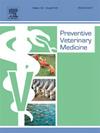An economic evaluation of preventing vs. suppressing HPAI outbreaks: A case study from Iowa
IF 2.4
2区 农林科学
Q1 VETERINARY SCIENCES
引用次数: 0
Abstract
This study presents an analysis comparing the costs of preventing Highly Pathogenic Avian Influenza (HPAI) in Iowa's poultry industry through wildlife management versus the costs of suppressing outbreaks once they occur. Using data from the USDA Animal and Plant Health Inspection Service's Veterinary Services and Wildlife Services, we conducted a cost-effectiveness analysis of prevention activities that reduce interactions between wild birds and domestic poultry. Our findings demonstrate that prevention efforts cost approximately $0.05 per bird, while suppression activities average $8.15 per bird in Iowa ($11.86 nationally). Results indicate that wildlife-based prevention programs would be cost-efficient, under current expenditures, if they reduced HPAI incidence by just over 3 %. The study provides compelling evidence that preventive wildlife management represents an opportunity for a more cost-effective approach to HPAI control compared to suppression measures alone, particularly given the recurrent and extensive economic impacts of recent outbreaks that have affected over 97 million birds nationally since 2022 and cost over $1.13 billion in response activities. These findings identify the need for continued evaluation of approaches to disease management to enhance the resilience of the U.S. poultry industry against the persistent threat of HPAI.
预防与抑制高致病性禽流感爆发的经济评估:来自爱荷华州的案例研究
本研究提出了一项分析,比较了通过野生动物管理在爱荷华州家禽业预防高致病性禽流感(HPAI)的成本与一旦爆发就进行抑制的成本。利用美国农业部动植物卫生检验局兽医服务和野生动物服务部门的数据,我们对减少野生鸟类和家禽之间相互作用的预防活动进行了成本效益分析。我们的研究结果表明,预防措施每只鸟的成本约为0.05美元,而在爱荷华州,每只鸟的抑制活动平均为8.15美元(全国为11.86美元)。结果表明,以野生动物为基础的预防项目如果能将高致病性禽流感的发病率降低3.5%以上,在目前的支出下将是具有成本效益的。该研究提供了令人信服的证据,表明与单独的抑制措施相比,预防性野生动物管理是一种更具成本效益的控制高致病性禽流感方法的机会,特别是考虑到最近的疫情反复出现和广泛的经济影响,自2022年以来,全国已有9700多万只鸟类受到影响,应对活动的成本超过11.3亿美元。这些发现表明有必要继续评估疾病管理方法,以增强美国家禽业抵御高致病性禽流感持续威胁的能力。
本文章由计算机程序翻译,如有差异,请以英文原文为准。
求助全文
约1分钟内获得全文
求助全文
来源期刊

Preventive veterinary medicine
农林科学-兽医学
CiteScore
5.60
自引率
7.70%
发文量
184
审稿时长
3 months
期刊介绍:
Preventive Veterinary Medicine is one of the leading international resources for scientific reports on animal health programs and preventive veterinary medicine. The journal follows the guidelines for standardizing and strengthening the reporting of biomedical research which are available from the CONSORT, MOOSE, PRISMA, REFLECT, STARD, and STROBE statements. The journal focuses on:
Epidemiology of health events relevant to domestic and wild animals;
Economic impacts of epidemic and endemic animal and zoonotic diseases;
Latest methods and approaches in veterinary epidemiology;
Disease and infection control or eradication measures;
The "One Health" concept and the relationships between veterinary medicine, human health, animal-production systems, and the environment;
Development of new techniques in surveillance systems and diagnosis;
Evaluation and control of diseases in animal populations.
 求助内容:
求助内容: 应助结果提醒方式:
应助结果提醒方式:


